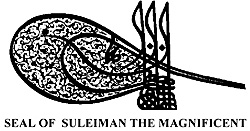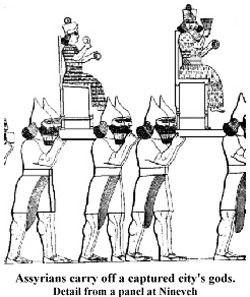 Saudi Arabia is a recent creation, but the
peninsula is rich in a history known to few
outsiders. In addition to the better known areas
that can found along its coasts -- such as
Jeddah, Taif, Tarut Island and Hofuf, a number
of inland historical venues are available.
These include the old Al Sa'ud capital at
Ad-Dariyah, Midian and the Nabatean ruins at
Madain Salleh. One of the more interesting
and out of the way collection of sites is nestled
on the northern edge of the great Nafud desert
at a place Al Jouf (var. Al-Jawf) in central
northern Arabia.
Saudi Arabia is a recent creation, but the
peninsula is rich in a history known to few
outsiders. In addition to the better known areas
that can found along its coasts -- such as
Jeddah, Taif, Tarut Island and Hofuf, a number
of inland historical venues are available.
These include the old Al Sa'ud capital at
Ad-Dariyah, Midian and the Nabatean ruins at
Madain Salleh. One of the more interesting
and out of the way collection of sites is nestled
on the northern edge of the great Nafud desert
at a place Al Jouf (var. Al-Jawf) in central
northern Arabia.
Assyrian Presence
Al Jouf means "cavity" or "basin", and properly denotes the whole lower region of the Wadi as-Sirhan. The regional name has, however, come to be applied to one of the oases in the basin. The area was known to the Late Assyrian Empire as Adumatu and to the Hebrews as Dumah. Assyrian chronicles show that Adumatu was the principal settlement in upper North Arabia from about 900-700 BC. Adumatu was then the seat of a series of North Arabian queens. Although brief mention of Queens Zabibe, Samsi and Iati'e do not defintively associate them with Adumatu (they are referred to as "Queen of Arabia"), Queens Te'elhunu and Tabua (Tarbua) are specifically associated with Adumatu --making it probable that the other three resided there as well.
Additionally, the fact that Queen Te'elhnunu is called the priestess of the goddess Dilbat (i.e. Ishtar), who was worshipped locally under the name Atarsamin, suggests that all these queens were high priestesses of this goddess. They seem to have exercised more than religious powers, however, for both Tiglath-Pileser III (744-27) and Sargon II (721-05) refer to their tribute on par with with Pi'ru of Marsu (i.e. "Pharoah of Egypt") and It'amar the Sabaean.
The exalted position of these queens can only be accounted for by the assumption that the cult of Ishtar/Atarsamain enjoyed tremendous prestige and popularity in North Arabia at that time. (In fact it has been suggested that "the confederation of the worshippers of Atarsamin" was used as a generic term for the northern Arabs).
For unclear reasons, though probably connected with a "rebellion" (which the Assyrians also used to mean failure to pay tribute on time) Adumatu was attacked by Sennacherib (704- 681):
From Adumatu, the stronghold of the Arabs which Sennacherib, king of Assyria, my own father, had conquered and from where he has taken as booty its possessions, its images as well as Iskallatu, the queen of the Arabs, and brought all these to Assyria, Hazail, the king of the Arabs, came with heavy gifts to Nineveh, the city where I exercise my rulership, and kissed my feet. He implored me to return his images and I had mercy upon him. I repaired the damages of the images of Atarsamin, Dai, Nuhai, Ruldaiu, Abirillu and Atarquruma, to the gods of the Arabs, and returned them to him after having written upon their statues an inscription proclaiming the superior might of Ashur.
In my own name I made Tarbua, who had grown up ion the palace of my father their queen and returned here to her native country together with her gods.
The Assyrians did not carry off the statues of the gods as mere booty. By taking away the images they stripped it of its divine protection in an era when the image and the god were one and the same.
The appointment of Tarbua as queen (and her residence in Sennaherib's palace) suggests an earlier period of client- vassalage. The above text, by the way, is the earliest recorded usuage of the word "Arab."
Esarhaddon, Sennacherib's son, tried to win the goodwill of the northern Arabs, by adding his own contribution to the temple.
He made a star of reddish gold which was decorated with precious stones [as an offering] for a happy life of his [own], prosperity to his offspring and the permanency of his kingdom.
But even this gesture did not pacify the northern Arabs. After Hazail's death, Esarhaddon made Haizal's son Iata, king of the Arabs, with an increase in tribute. This apparently did not sit well and
Wahb induced all the Arabs to revolt against Iata because he wanted to become king. But I, Esarhaddon to whom crookedness is an abomination sent out a contingent of bowmen mounted on horseback from my army and pacified the Arabs making them submit again to Iata. They brought Wahb and the warrior of his entourage to Assyria. I put collars on them and bound them to the left side of the Metalworker's Gate in Nineveh.
Although the chief god of Adumatu and possibly of North Arabia was the goddess Ishtar/Atarsamain, five other divinities appear in the list of Arab Gods carried off from the oasis by Sennacherib -- Dai, Nuhai, Ruldaiu, Abirillu amd Atarquruma. They also had shrines of their own in the oasis, possibly as part of the temple complex of Ishtar/Atarsamin. Al Jouf must have been damaged severely in the attempts of the Assyrians to subdue the tribes of Northern Arabia. Ashuranipal (668-27) boasts in one campaign against Uate, "the king of the Arabs" that he inflicted a crushing defeat on them and took back so much booty to Nineveh that:
They [camels] filled up completely the entire extent of [Assyria]. I distributed camels as if they be sheep. Camels were bought for less than one shekel of silver in the market place. The female tavernkeeper received camels as a gift; the brewer for a hapu of beer, the gardener received a camel for a basket of fresh dates.
After the Assyrians
It is also possible that Adumatu was sacked when the Neo-Babylonian king Nebuchadrezzar "smote Qedar and the kingdoms of Hasor" (Jer. 49:28-33). But the blow was not mortal, for both continued to flourish after the Babylonian emperor withdrew. It is also possible that the city was again sacked ca. 552 BC by Nabonidus. Following the collapse of the Neo-Babylonian (Chaldean) empire in 539 BC, Al Jouf may have been occupied by the Persians but this is not clear. Xenophon states that Cyrus subjugated the Arabs before he sacked Babylon. Herodotus claims "that the Arabs were never reduced to the subjection of Persia." but he also states that the Arabs sent Cyrus an annual gift of 1000 talents of incense (112,000 pounds, ie 55 tons). Furthermore one of Cyrus' inscriptions states that "all the kings of the West land living in tents brought their heavy tributes and kissed my feet in Babylon." Still there is no evidence of Persian garrisons or a satrap being established.
By the first century AD the area was under the control of the Nabataeans (an inscription from 44 AD is still visible). No evidence of a permanent Assyrian or Chaldean occupation exists. But this may be due to the absence of any large rock outcropping which both would customarily use to attest to their presence.
 At right: Assyrians carry off a captured city's gods. Detail from a panel at Nineveh.
At right: Assyrians carry off a captured city's gods. Detail from a panel at Nineveh.
The Sites of Al Jouf
Al Jouf's attraction, and the source of its prosperity, was its strategic position on the major trade routes between the Arabian peninsula, the Levant, Egypt and Mesopotamia. The crossroads oasis formed a natural magnet for merchants, travelers, and, in the early Islamic period, pilgrim's destined for the Hajj'. In fact, one of Al Jouf's oldest and most treasured sites is a simple clay and stone structure called Omar's mosque. Resting on foundations laid out by the second Caliph, the mosque has been in continuous use for over fourteen hundred years.
There is a museum in the area staffed by Department of Antiquities archaeologists. Neighboring the museum's grounds is Al Jouf's visually most impressive sight, the Qasr Mared. Constructed of mud and stone bricks and over 1700 years old, the Qasr Mared was the main fortress guarding the area. Stone towers and cyclopean walls were reminders of a time when Al Jouf needed to be continuously defended and garrisoned.
To the northwest of Al Jouf is Sakaka, another oasis town which is now the administrative center for the Emirate. Near the center of town is another fortress, the Qasr Zabal. A "mere" 175 years old, the Qasr Zabal is young by Joufian standards but as awe-inspiring as the Qasr Mared. Sitting high atop a rock outcrop that is approachable only by climbing a winding spiral trail that repeatedly wraps around the hill, the fortress dominates Sakaka. The Qasr's four distinctive towers act as a landmark for the area. Huddled against the hill is an old village whose unique architecture makes it worth more than a cursory look.
Another important archaeological site is only a short distance away from Qasr Zabal in terms of space, but separated from this "modern" fortress by four millenia in time. Covering an area larger than Stonehenge, the Rajajil dates back to the Copper Age. The Rajajil is composed of free standing roughly carved stone pillars up to three meters in height and arranged in linear groups along a general northerly bearing. The actual purpose of these pillars remains a mystery.
Modern day Al Jouf has its own charms and surprises to offer. The Abdul Rahman Al Sudairi Charity Foundation in Sakaka houses one of the most extensive and complete collections of local folk art in the region specializing in "daily life" items ranging from hand carved water wheels to farm implements, camel saddles, clothes irons and other household tools.
Local farms display the richness of this fertile oasis in the quantity and variety of plants present. The Al Jouf region is unique in Saudi Arabia in that not only do Mediterranean type crops grow there, but they thrive. Here, only a few kilometers from the forbidding sterility of the Great Nefud, were trees, bushes and vines bearing heavily with grapes, dates, figs, olives, lemons, pomegranates, oranges and other crops normally found on the Mediterranean coast. Al Jouf is living proof of the ancient and vibrant history the Arabian peninsula possesses.
Ishtar: From Goddess of Fertility to Goddess of Lust
Back to Cry Havoc #5 Table of Contents
Back to Cry Havoc List of Issues
Back to MagWeb Master Magazine List
© Copyright 1993 by David W. Tschanz.
This article appears in MagWeb (Magazine Web) on the Internet World Wide Web. Other military history articles and gaming articles are available at http://www.magweb.com